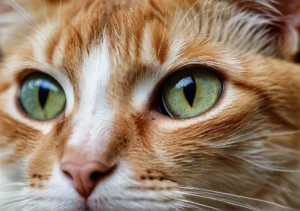Calico cats strut their stuff with a mishmash of vibrant colors that could make even the rainbow jealous. But when it comes to finding a male among these colorful felines, it feels like looking for a needle in a haystack. In this post, you’ll discover the fascinating genetics behind why most calico cats are female and the rare chance of finding a male calico.
Key takeaways:
- Male calico cats are a rare genetic marvel due to their XXY chromosome configuration, occurring in about 1 in 3,000 calico cats.
- Most male calico cats are sterile and may have health issues, such as Klinefelter Syndrome, requiring more attentive care.
- These stunning felines are enveloped in folklore, often considered lucky charms and harbingers of good fortune across cultures.
Can Calico Cats Be Male?
When we delve into the colorful world of calico cats, we’re wading into a pool glittering with genetic wonders.
To put it simply, for a cat to don the stunning calico coat—splashed with black, orange, and white—they need two X chromosomes. This is because the genes that determine the black and orange colors are found on the X chromosome. Females have two X chromosomes (XX), thus, they can easily be calico. Males, on the other hand, typically carry one X and one Y chromosome (XY), laying out the blueprint for either all black or all orange coloring, but not a mix.
Now, you might wonder, does this rule out male calico cats entirely? Not exactly, but it makes them a real rarity.
What Makes Male Calico Cats So Rare?
Cue in the fascinating genetic anomaly of XXY chromosome configuration. This rare configuration occurs when a male cat inherits an extra X chromosome (XXY), bringing the calico possibility into play. However, landing on this genetic lottery ticket is far from common. The occurrence is so rare that it happens in approximately 1 out of every 3,000 calico cats. Imagine the odds!
This genetic rarity is not just a brief mention in biology textbooks; it’s a startling reality that makes male calico cats extraordinarily unique. Yet, with this uniqueness comes not just rarity but also a host of potential health issues, a shadow that often follows closely behind many genetic anomalies.
Are Male Calico Cats Different from Female Calicos?
On the surface, male calico cats strut the world in their tri-colored coats much like their female counterparts, turning heads and stealing hearts with their vivid hues. However, beneath the surface, their genetic makeup sets them apart.
One significant difference lies in their reproductive capabilities. Most male calicoes are sterile due to their XXY chromosome configuration. This means they cannot sire kittens of their own, a distinction that has both pros and cons. On the plus side, it cuts down the concern for contributing to overpopulation. However, it also means that the already rare male calico cannot pass on his unique coloring to offspring.
But here’s a unique insight that many discussions on calico cats miss: although male calicos share the same vibrant coats as females, their health outlook can differ substantially. Male calicos are predisposed to Klinefelter Syndrome, a condition stemming from their extra X chromosome. This syndrome can manifest in various health issues, including increased susceptibility to infections, heart problems, and complications with their bones. Consequently, they may require more attentive care, regular vet check-ups, and a loving, observant owner.
In terms of behavior, there’s anecdotal evidence suggesting male calicos might possess a more docile and affable temperament compared to typical males. However, temperament can vary widely among individual cats, and environment plays a significant role.
So, are male calico cats different? Absolutely, from their genetic blueprint right down to their potential health hurdles. They stand out as a marvel in the feline world, showcasing nature’s penchant for bending its rules. If you’re lucky enough to cross paths with a male calico, know that you’ve encountered a truly rare gem.
Remember, while they might require a bit more care due to their unique genetic makeup, the love and companionship they offer are as boundless as any cat’s. Whether male or female, calico cats are dazzling creatures, each with their individual flair and persona, ready to enrich our lives in their colorful ways.
How Can You Tell If Your Calico Cat Is Male?
So, you’ve got a calico cat, and you’re curious about its gender? Well, buckle up because distinguishing the gender of your colorful feline friend can be quite the rollercoaster, especially given the rarity of male calicos. But no worries, we’re here to guide you through some practical advice on how to identify if your calico cat struts on the male side of the alley.
First off, the color giveaway. Remember, calico isn’t a breed; it’s all about that color pattern—white, black, and orange. This coloration is closely linked to the X chromosome, and since males have one X and one Y chromosome (XY), it’s super rare for them to exhibit these colors. However, male calicos typically come into play due to a genetic anomaly, like having an extra X chromosome (XXY).
Next up, let’s talk behavior. While physical traits are a go-to, behavior can sometimes give you a hint too. Male cats, including calicos (though they’re unicorns in the cat world), tend to be more territorial and may spray more often than their female counterparts. However, it’s essential not to take this as a concrete rule since a cat’s behavior can vary widely based on individual personality and whether they’ve been neutered.
Physical examination
– Look under the tail: Male kittens have a noticeable space between the anus and the urinary tract opening, while females have these openings closer together.
– Check for testicles: In unneutered males over 10 weeks old, you’ll likely notice two small bulges under the skin between the anus and the urinary tract opening.
But here’s the kicker, the unique piece of advice you came here for: If you’re still unsure, look for a bicolor nose or split face coloration. It’s not a definitive sign, but male calicos sometimes exhibit these traits more distinctively due to their unique genetic makeup.
When in doubt, a visit to the vet can clear up any confusion. Vets have the skills to determine the gender of kittens as young as a few weeks old. Besides solving the mystery, it’s a great opportunity to ensure your calico cat is healthy and to discuss potential neutering options, especially for a male calico which may have more complicated health issues due to their rare genetic configuration.
Why Are Male Calico Cats Considered Lucky?
Now, onto the intriguing world of folklore and superstition. Male calico cats are not just a rarity; they’re often enveloped in a shroud of luck and mystical allure. Across different cultures, these vibrant felines have quite the reputation, and for a good reason.
In many traditions, male calico cats are seen as harbingers of good fortune. This belief stems from their scarcity; they’re like the feline world’s version of a four-leaf clover. But why, you ask?
Firstly, maritime lore plays a significant role. Sailors believed that calico cats could protect their ships from storms and ghosts, and with male calicos being so rare, their presence was considered an even stronger charm against the perils of the sea.
In Japanese culture, the Maneki-neko, or the “beckoning cat,” is a common figurine that is believed to bring good luck and fortune. Though not always depicted as a calico, the ones that are, are highly prized. It’s said that a male calico Maneki-neko doubles the luck, drawing wealth and prosperity like a magnet.
Here’s another fascinating tidbit: owning a male calico is sometimes thought to attract love and affection. The uniqueness and rarity of the cat are believed to mirror in the owner’s love life, bringing about unexpected but delightful encounters.
Furthermore, their rarity makes them highly sought after. In some instances, male calico cats have been sold for hefty sums, or at the very least, they find homes remarkably quickly. This desirability, however, should never overshadow the importance of responsible pet ownership. Remember, every cat, regardless of its color or gender, deserves a loving and safe home where they’re valued beyond superstitions.
In conclusion, whether drawn by the allure of good fortune or simply enchanted by their unique coloration and rarity, male calico cats indeed hold a special place in the hearts of many. If you’re lucky enough to share your home with one of these exceptional felines, remember that luck is merely one of the many joys they bring into our lives.
Alex, a passionate animal lover, has experience in training and understanding animal behavior. As a proud pet parent to two dogs and three cats, he founded AnimalReport.net to share insights from animal experts and expand his knowledge of the animal kingdom.





